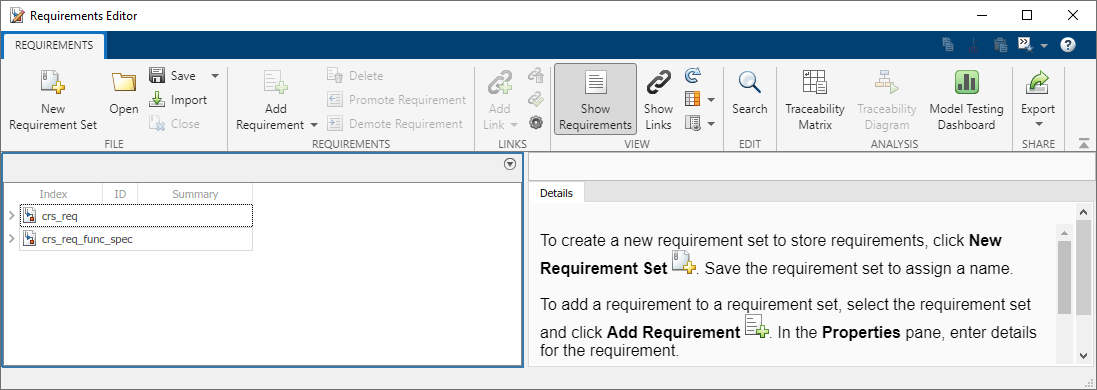在 MATLAB 或 Simulink 中编写需求
在 Requirements Toolbox™ 中,将需求组织在称为需求集的组中。在每个需求集中,如果您需要进一步描述需求的详细信息,可以创建额外的层次结构级别。
在本教程中,您将使用需求编辑器创建需求集、组织相关需求以及向该需求集添加需求。如果您有 Simulink®,还可以使用需求透视编写需求,而无需退出 Simulink 编辑器。有关使用需求透视的详细信息,请参阅在 Simulink 中查看和链接需求。
假设您正在编写汽车巡航控制系统的控制器模型的需求。您可以使用所在公司的编号标准(R1、R2 等)来制定这些需求。
| ID 和描述 | 理由 |
|---|---|
| R1:最大输入油门为 100% | 加速踏板的油门最大值不能大于 100%。 |
| R2:巡航控制具有速度工作范围 | 巡航控制具有最小和最大工作速度。 |
| R2.1:车辆速度必须至少为 40 公里/小时 | 车辆的速度必须至少为 40 公里/小时,巡航控制系统才能启动。 |
| R2.2:车辆速度不能超过 100 公里/小时 | 车辆巡航控制系统的最大工作速度为 100 公里/小时。 |
这些需求捕获了在名为 crs_controller 的模型中建模的功能。
打开包含该模型和支持文件的
CruiseRequirementsExample工程。在 MATLAB® 命令提示符下,输入:openExample("slrequirements/CruiseRequirementsExample")在需求编辑器中打开需求集
crs_req。在命令提示符下,输入:slreq.open("crs_req")需求编辑器会显示按需求集排列的需求。该工程有两个需求集:
crs_req_func_spec和crs_req。
添加需求集。在需求编辑器工具条中,点击新建需求集。
将需求集保存到外部文件中。将您的需求集保存到可写位置,并将其命名为
cruise_control_reqset.slreqx。选择您的需求集并点击添加需求,以向需求集添加需求。
在右窗格的属性下,输入需求的详细信息。输入需求的详细信息:
自定义 ID:R1
摘要:最大输入油门百分比
描述:最大输入油门为 100%。
如果您未指定自定义 ID,则需求编辑器会按顺序对需求进行编号。借助自定义 ID,您可以使用公司标准来标记需求并设置数值顺序。(自定义 ID 不能包含 # 字符。)您还可以在搜索时使用 ID 来帮助查找需求。关键字也有助于搜索需求。
创建需求
R2。点击添加需求。输入需求的详细信息:自定义 ID:R2
摘要:巡航控制速度工作范围
描述:巡航控制具有最小和最大工作速度。
选择
R2并依次点击添加需求 > 添加子需求,为R2创建子需求。输入需求的详细信息:自定义 ID:R2.1
摘要:最小车辆速度
描述:车辆的速度必须至少为 40 公里/小时,巡航控制系统才能启动。

重复此步骤以向
R2添加其他子需求。
您可以使用  提升需求或
提升需求或  降低需求来重新排列层次结构。
降低需求来重新排列层次结构。
您还可以通过点击并拖动需求来重新排列层次结构。要将某个需求移动到与其他需求相同的层次结构级别,请在其他需求之间拖动,直到出现黑线。要将需求添加为子需求,请在所需的父需求上拖动,直到黑线包围该父需求。
使用 Microsoft Word 编写和编辑需求内容
要编写和编辑需求的描述和理由字段,请在需求编辑器或需求透视视图中打开 Microsoft® Word。
注意
此功能仅在 Microsoft Windows® 平台上可用。
通过使用 Microsoft Word 编辑富文本需求,您可以:
对需求内容进行拼写检查。
调整图像大小。
插入和编辑方程,包括使用 LaTeX 格式插入和编辑方程。有关详细信息,请参阅 Microsoft 网站上的在 Word 中使用 UnicodeMath 和 LaTeX 编写线性格式方程。
插入和编辑表。
在编辑字段工具栏上的描述或理由字段中,点击  图标。在 Microsoft Word 中保存对需求内容的更改,以便它们反映在 Requirements Toolbox 中。
图标。在 Microsoft Word 中保存对需求内容的更改,以便它们反映在 Requirements Toolbox 中。
如果您导入以前使用 Microsoft Word 编辑的需求,则会丢失格式元素。例如,方程式会变为不可编辑的图像。
自定义需求浏览器视图
点击 列 > 选择属性时,可以在需求编辑器中查看或隐藏列。在列选择器中可以添加和删除属性列以及对属性列进行重新排序。视图配置将跨会话保存。您可以使用
列 > 选择属性时,可以在需求编辑器中查看或隐藏列。在列选择器中可以添加和删除属性列以及对属性列进行重新排序。视图配置将跨会话保存。您可以使用 slreq.exportViewSettings 函数将视图设置导出到 MAT 文件中,使用 slreq.importViewSettings 函数导入视图设置。您可以使用 slreq.resetViewSettings 函数重置视图配置。
过滤需求内容
点击搜索,可以搜索需求内容。可以根据需求属性和描述在加载的需求集中查找特定需求。
指定过滤文本字符串 - 当您在搜索文本框中输入文本时,需求浏览器会执行动态搜索并显示结果。搜索操作仅适用于您选择在需求浏览器中显示的属性。
您输入的文本字符串必须符合以下部分中描述的规范。
大小写 - 默认情况下,需求浏览器在过滤时会忽略大小写。
如果您希望需求浏览器区分大小写,请用双引号将文本引起来。
指定属性和属性值 - 要将过滤限制为具有特定属性的需求,请键入属性名称,后跟冒号。这样需求浏览器仅会显示具有该属性的需求。
要过滤特定属性具有特定值的需求,请键入属性名称,后跟冒号 (:),然后键入值。例如,要过滤内容以仅显示 Summary 属性的值包含 Aircraft 的需求,请输入 Summary: Aircraft。或者,用双引号将字符串引起来以强制区分大小写。
不支持通配符和 MATLAB 表达式 - 需求浏览器无法识别通配符,例如 *。例如,即使需求包含文本字符串 fuel,搜索 fuel* 也不会返回任何结果。
此外,如果您在搜索文本框中指定 MATLAB 表达式,则需求浏览器会将该字符串解释为文本,而不是 MATLAB 表达式。